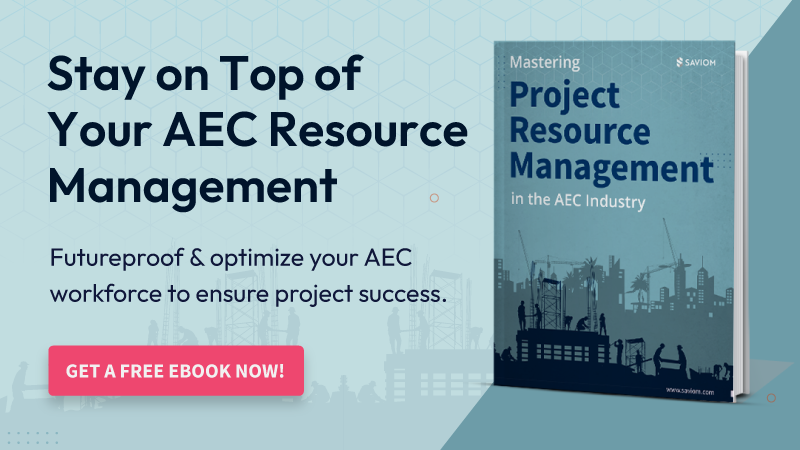“According to Business Wire, the global construction industry is expected to reach an estimated $10.5 trillion by 2023.”
The major drivers for the growth of this market are the ever-growing demand for real estate and modern infrastructure. However, in spite of the surge, the AEC industry faces numerous challenges today. Some of them include- economic uncertainties, supply chain bottlenecks, high equipment costs, etc.
Besides, resourcing challenges such as skill gaps, attrition, aging workforce, etc., also adversely affect construction firms.
In the absence of effective solutions or if any aspect is overlooked, these issues can cause budget or schedule overruns and lead to project failure, thereby impacting the financial health of firms. Therefore, organizations must implement appropriate measures to mitigate these challenges and remain profitable in the competitive market.
This article explains some of the most significant resourcing challenges in the AEC industry and ways to combat them.
Let’s begin.
An overview of the AEC industry
AEC stands for Architectural, Engineering, and Construction, which describes the alliance of architects, engineers, and laborers on construction-related work such as designing, concreting, carpentry, plumbing, electrical work, etc.
Let’s understand the characteristics of this sector in depth:
- The AEC projects are workforce-driven, i.e., the firm requires diverse expertise to achieve the deliverables successfully. From highly skilled architects to engineers and on-site workers, every resource is valuable for successfully delivering construction projects. In addition, estimators, supervisors, contractors, equipment, materials, etc., are other critical resources in this industry.
- Each construction project is unique and is attributed to different geographical and weather conditions. For example- if two identical buildings are to be constructed at different places, the soil properties, site characteristics, climatic conditions, environment, etc., will introduce multiple variations in the project.
- The recruitment pattern of AEC firms is entirely different from other industries. They mainly recruit contractual workers in a bulk manner who are paid on an hourly/daily basis. These resources are not selected as per their certifications or academic qualifications but are solely hired based on their manual skills.
- The construction industry has witnessed a paradigm shift due to significant technological advancements and emerging digital architecture and engineering trends. For example- the new 3D printing technology is helping architects visualize the project even before its execution. Further, eco-friendly buildings have revolutionized the field of architecture and secured the future of urbanization by being a sustainable approach. For example- People are opting energy-efficient materials such as straw bales, plant-based polyurethane foam, plastic composite lumber, etc., to build infrastructures.
Now that we know the nitty gritty of the AEC industry let’s carefully analyze the resourcing challenges and ways to combat them.
Resourcing challenges in the AEC sector and ways to overcome them
Construction firms utilize a large number of employees to fulfill their project activities. However, this also brings forth numerous bottlenecks.
Below are some significant resourcing challenges with their relevant solutions –
Difficulty in consolidating AEC resource data due to siloed information
Many AEC firms still rely on legacy tools and traditional spreadsheets to manage their resources. However, these tools store siloed information and cannot provide real-time data about various resource attributes such as availability, schedules, etc. As a result, managers find it difficult to consolidate the data, leading to delayed decisions. Furthermore, a lack of visibility into AEC resources’ present and future schedules can result in double bookings, wasteful hiring/firing cycles, etc.
So, what is the solution?
Sol: Create a centralized database for a single version of the truth
To prevent this, AEC firms can use an enterprise resource management tool to eliminate silos of data within an organization and provide a single version of the truth. The 360-degree visibility and the advanced search filters give a bird’s eye view of the entire construction workforce.
This allows them to narrow down the resources based on their profile and other attributes like their skills, competencies, cost rate, availability, and capacity. Then, managers can assign them to different projects in advance, avoiding data duplication and double bookings.
Lack of foresight into future AEC projects
Given the complex nature of the AEC projects, companies need to plan ahead of the curve to ensure that the right resources are available before the project’s onset. However, if the construction managers fail to foresee and predict future project demand, it triggers last-minute firefighting of resources for the right engineers and workers. This causes increased hiring costs and the onboarding of incompetent resources.
So, how to combat this?
Sol: Ensure effective capacity planning ahead of the curve
The construction managers can use ERM software to get foresight into the pipeline AEC project’s resource requirements. Capacity vs. demand reports helps identify the excess or shortfall of resources and take remedial measures ahead of time.
If there is a shortage of skilled engineers, managers can initiate planned hiring or else can out-rotate niche civil engineers and architects from ongoing projects. On the contrary, in case of an excess, the construction managers can mitigate it by bringing forward projects, adjusting timelines, training or selling excess capacity, etc. Therefore, forecasting and gauging the gap removes the risk of last-minute hiring hassle and helps optimize the workforce for pipeline projects.
Read More: How to Implement Effective Resource Capacity Planning in AEC Industry?
Growing skill gap and labor shortages of AEC resources
“According to a recent survey, only 3% of young people were interested in pursuing careers in the construction field.”
Due to the current resources retiring and the lack of a new-generation workforce, there is an acute labor shortage in the AEC industry. Furthermore, this industry demands a high demand for skilled engineers due to ever-evolving customer expectations and global competition. As a result, many construction firms are looking for resources with advanced skills like – AutoCAD, AR/VR, 3D printing, etc. However, since the existing talent pool is not well-versed with these tools and tech, the skills gap is widening tremendously.
So, how to mitigate this challenge?
Sol: Provide training & upskilling programs to impart industrial knowledge
To keep up with the disruptive technologies such as SketchUp, Revit, Blender, FLAC 3D, etc., in the AEC industry, workforce skills must be updated periodically to avoid obsolescence. Thus, managers can view the organization’s competency matrix and arrange appropriate training and development initiatives for their resources.
In addition to that, they can identify competent resources to fill critical positions as part of the company’s succession planning. These resources can undergo requisite training to prepare for the new roles and responsibilities. This will help the firms future-proof the workforce with the right skills and expertise to take up new and advanced projects.
Increase in bench size in the AEC firms
The majority of AEC projects are prone to frequent ramp-ups/downs. The managers may assign hundreds of workers during the procurement and construction phase. However, these resources are released once the project is at the closure phase. Due to this, employees, such as construction workers and engineers, end up on the bench, impacting business profitability.
So, how to reduce the bench size?
Sol: Manage ramp-up & ramp-downs of construction projects proactively
The construction managers can use a resource management tool that offers people on the bench and project vacancy reports. This will help them get a clear picture of the resources that will end up on the bench. Accordingly, they can take course corrective actions and proactively allocate them to suitable vacancies before getting rolled off.
For instance, managers can foresee ramp-down activities from the project and assign suitable work beforehand. Moreover, they can also provide upskilling/training to benched employees and utilize them on future projects. This can facilitate continuous productivity and high performance.
Read More: How to Balance Ramp-Ups and Ramp-Downs in a Project?
Inability to track the utilization of workers at the construction site
AEC firms can only be profitable if their labor force works on projects generating revenue. Therefore, it is vital for managers to track every billable activity of their workers. However, due to a lack of real-time utilization data, managers face difficulty in monitoring and optimizing the construction resources. As a result, they cannot adequately identify if the engineers are being optimally utilized. It eventually leads to sub-par deliverables, project delays, and budget overflow.
So, how can managers track this?
Sol: Use an advanced resource management tool
With a modern ERM tool, construction supervisors can easily view the utilization levels of all the architects and construction workers under their span of control. They can leverage color-coded heatmaps to monitor and analyze if the professionals are being over or underutilized. Additionally, forecast vs. actual reports helps identify the variance and align future estimations to reality.
Further, the managers can also analyze if the architects are working on billable or non-billable project activities. Consequently, they can mobilize them from non-billable work to billable activities. This way, the AEC firms can improve the billability of the resources and enhance organizational profitability.
Rising unplanned attrition among skilled architects due to competitor poaching
“According to a survey, nearly 32 percent of the employees said they left their previous jobs because of low salaries.”
If the AEC firm fails to match pay scales and compensations with market standards, it can leave the skilled architects discontented. Additionally, biases in salaries in the same roles can also generate dissatisfaction among the engineers. As a result, they may decide either to quit their current company or be approached by a competitor firm that can offer a higher salary. Further, long working hours, no appreciation, lack of autonomy, poor work-life balance, etc., can also cause stress and high burnout among the architects, thereby increasing attrition rates in the firms.
So, what can the firms do to prevent attrition?
Sol: Implement effective compensation planning as per market standards
The AEC firms should create competitive remuneration policies as per the market standards. For example, they should provide salaries, benefits, incentives, equity, retirement plans, bonuses, etc., to the engineers and workers. Also, managers can make sure to eliminate any pay differences for similar roles. It will make the employees feel that their work is valued and are fairly compensated by the firm.
The firms can also offer workers medical insurance to cover any injuries they might suffer on-site. Furthermore, organizations can provide vehicle and accommodation allowances when the AEC workforce travels to the project sites. This helps enhance engagement levels, increases productivity, and makes them committed to staying, reducing unplanned attrition.
Read More: 7 Effective Retention Strategies for Niche-Skilled Resources
Obsolescence of construction equipment’s and machineries
Equipment procurement and maintenance costs can significantly contribute to the AEC industry’s capital investment and must be appropriately managed for higher ROI. It is, therefore, critical to identify the right time to upgrade equipment and machinery to prevent obsolescence. In addition, malfunctioning of the equipment forces the majority of the work to be done manually, making the project time-consuming. For example, a concrete mixer is used to create large batches of concrete. However, if the machine fails, the construction workers are forced to mix the material by hand, making the task tedious.
So, how to track the equipment lifecycle?
Sol: Leverage effective equipment management solution
The AEC firms can use the equipment scheduling solution that helps track the machinery’s lifecycle and provides early warning for the equipment to be replaced. This keeps managers forewarned of equipment nearing maintenance and service dates, avoiding damage.
Further, it also provides lead time to buy and install the new components and equipment. This ascertains that upgraded, high-end machinery is being used for all types of construction projects. Thus, it reduces manual and mundane activities, thereby increasing the productivity and performance of workers.
Increased safety risks and hazards for onsite AEC employees
“According to a survey, the AEC industry currently rates in second place behind the agricultural, fishing, and forestry industry for the most work-related injuries.”
The construction industry is deemed dangerous because of the combination of health and safety risks involving vehicles, equipment, and manual tasks that employees carry out. For example- The construction of buildings and demolitions often require staff to work from height. However, workers can slip due to a lack of safety nets and harnesses, leading to severe injuries. Similarly, these sites are places of constant movement of heavy vehicles and equipment. But, due to a lack of proper lighting or little space to maneuver, the workers/engineers can trip and suffer abrasion.
So, how to avert this?
Solution: Implement appropriate precautionary measures for construction workers
Construction sites are one of the few workplaces where the risks can’t be eradicated, but can be minimized. Therefore, managers must develop a site-specific safety plan and conduct site surveys to verify that proper barriers and restriction signs are in place. They should also be aware of all the industrial safety management rules and regulations to keep workers safe during emergencies like natural disasters, fire, hazardous material spills, etc.
The onus is on supervisors to check if the crew always wears appropriate personal protective equipment (PPE) while working. Further, the workforce must be fully informed and trained to use the various equipment safely. Moreover, the excavation sites should be regularly inspected before and during shifts to ensure it is fully secured.
Read More: Top 7 AEC Industry Trends to Look for in the 2020s and Beyond
The Bottom line
The AEC sector is plagued by various resource-centric challenges due to the ongoing advancements and emergence of new technology trends in the global market. These challenges will negatively impact construction projects and profitability if not appropriately handled.
Therefore, taking a proactive approach combined with an advanced ERM tool can help AEC industries anticipate and effectively mitigate resourcing challenges. Moreover, it can help them futureproof their workforce and ensure business sustainability and profitability amidst volatile market conditions.
So, are you ready to implement these effective measures and achieve fruitful results?
The SAVIOM Solution
SAVIOM is the market leader in helping multinational clients manage their resources efficiently and effectively. With over 20 years of experience, this Australian-based MNC has a global presence across 50 countries and has helped 100+ clients with their Workforce Planning Software. Saviom also provides tools for Enterprise Project Resource Management, Project Portfolio Management, and Professional Service Automation.












